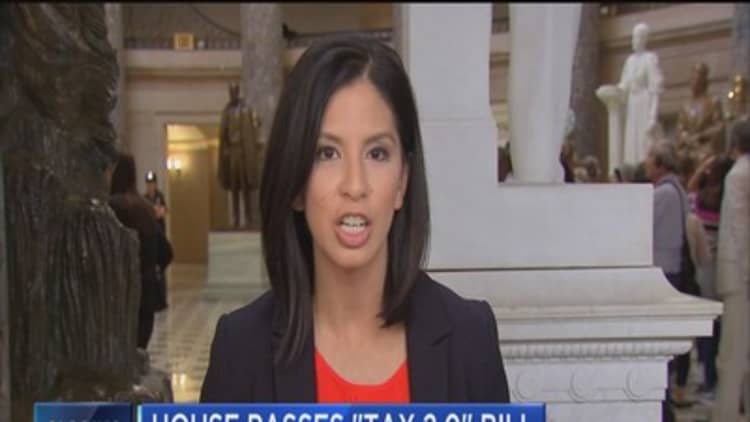Here's one good reason for the happily married to rejoice: They have better access to a tax-friendly retirement savings strategy.
Generally, a Roth individual retirement account allows savers to put away up to $5,500 (plus $1,000 if you're age 50 or older), have the money grow free of taxes and then tap it in retirement on a tax-free basis.
As useful as these accounts may be, not everyone will have access to them. Taxpayers whose modified adjusted gross income exceeds $120,000 if single or $189,000 if married won't be able to make the full contribution directly to a Roth IRA.
That's where Roth conversions come in: You take a chunk of traditional IRA dollars, pay income taxes and convert it to a Roth IRA. Income limits do not apply to conversions.
Be aware that This move is a permanent one.
The Tax Cuts and Jobs Act put an end to "recharacterizations," or the unwinding of Roth conversions that were completed after the end of 2017. If you made a Roth conversion last year and you'd like to undo it, you have until Oct. 15 to do so.
Married couples weighing a Roth conversion have an added sweetener, according to Robert S. Keebler, CPA and partner with Keebler & Associates.
He spoke at the Financial Planning Association's annual conference in Chicago on Monday.
"The income tax brackets are more favorable for married people, so convert while both spouses are alive," he said.
Here's why a Roth conversion might be a great deal for couples.
Softer brackets
The Tax Cuts and Jobs Act not only trimmed individual income tax rates across the board, it also broadened the income tax brackets for married couples.
This allows higher-income households to remain in lower brackets and be subject to friendlier top rates.
See below for a breakdown of the 2018 tax brackets for singles
| Rate | Taxable Income Bracket |
|---|---|
| 10% | 0 to $9,525 |
| 12% | $9,525 to $38,700 |
| 22% | $38,700 to $82,500 |
| 24% | $82,500 to $157,500 |
| 32% | $157,500 to $200,000 |
| 35% | $200,000 to $500,000 |
| 37% | $500,000 and up |
This is what the 2018 brackets are for married couples.
| Rate | Taxable Income Bracket |
|---|---|
| 10% | 0 to $19,050 |
| 12% | $19,050 to $77,400 |
| 22% | $77,400 to $165,000 |
| 24% | $165,000 to $315,000 |
| 32% | $315,000 to $400,000 |
| 35% | $400,000 to $600,000 |
| 37% | $600,000 and up |
A couple with taxable income of $300,000 in 2017 would have been in the 33 percent bracket. Under the current law, that same couple would be in the 24 percent bracket.
In effect, the new tax law has created "softer brackets," said Keebler.
Converting while you can
Since higher-income couples have a longer runway before they begin to hit the higher brackets, they might be in the best position to make Roth conversions now.
They pay income taxes on the amount converted, and with lower rates and wider brackets, the taxes won't sting as much now as they would have prior to the new tax law.
Bear in mind that the lower rates for individuals aren't permanent and they may revert to the old structure after 2025. The House GOP is pushing to make lower rates permanent as part of Tax Reform 2.0.

Converting now while you can still file as a married couple is also helpful because the brackets are narrower for single people. This means it's easy for a single person to bump up into a higher tax bracket when converting their traditional IRA to a Roth.
"Why haven't people talked about doing conversions while the spouse is still alive?" asked Keebler. "Right now, it makes more sense."
Beware: Pro rata rule
Proceed with caution and work with a professional when you make a Roth conversion.
In the event you made non-deductible – or after tax – contributions to a traditional IRA and expect to convert that amount to a Roth, you could run into a tax hiccup known as the "pro rata rule."
If you already own other IRAs with pretax amounts in them, the IRS could subject you to income taxes based on the overall value of all the accounts — and not just the amount that you're converting.
What you have saved in your traditional IRAs, along with your SEP and SIMPLE IRAs, would be included in this calculation.
This is known as the pro rata rule.
You can also get tripped up on the pro rata rule if you convert a nondeductible IRA at one point in the year and then later that same year you rollover a 401(k) into a traditional IRA.
That's because the pro rata rule considers your IRA balances at the end of the year.
More from Fixed Income Strategies:
Did a Roth IRA conversion? What you might need to do next
Answer this question right and you'll have a good retirement
Watch out for the yield curve
WATCH: Here's what the new tax law means for your retirement






